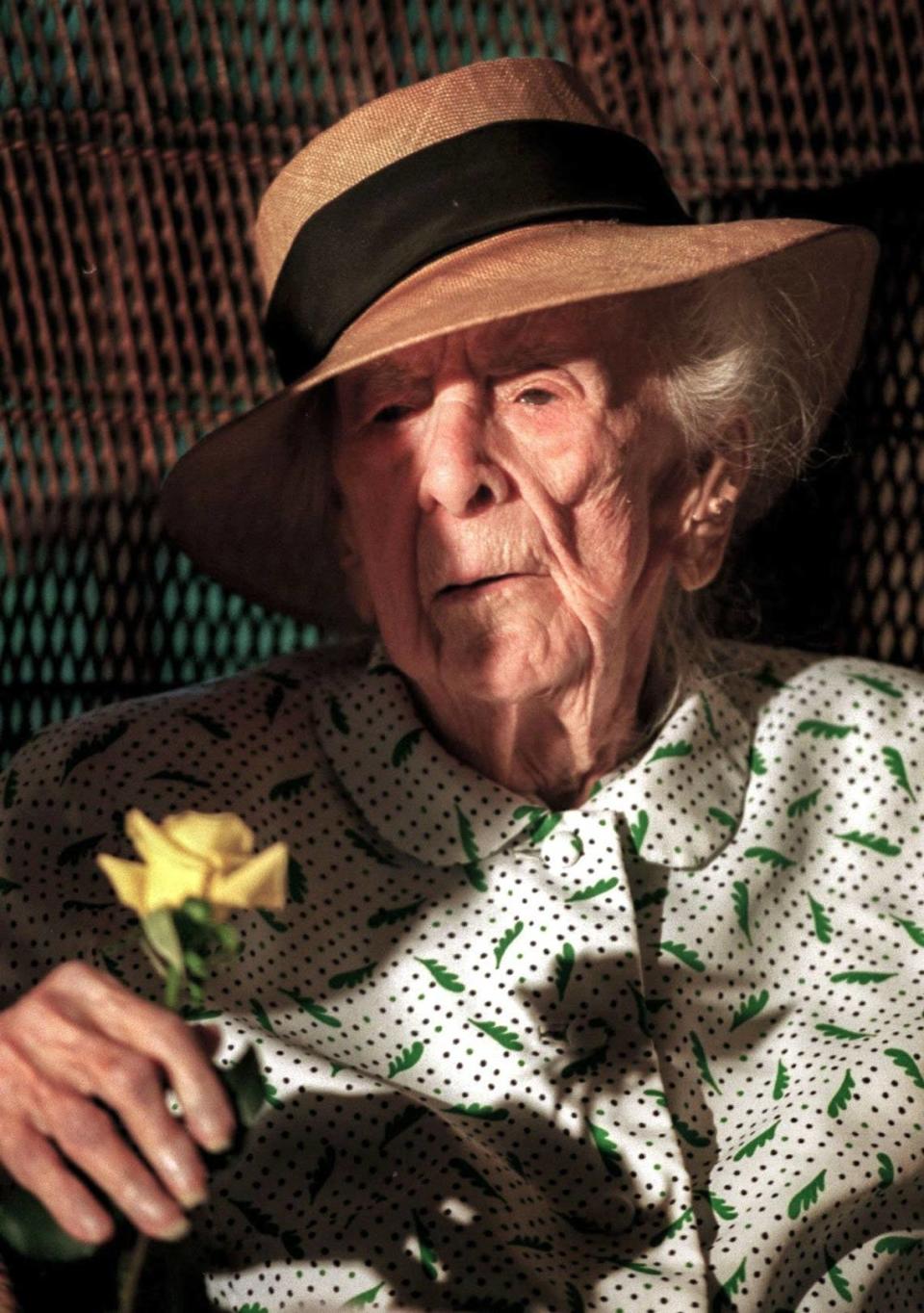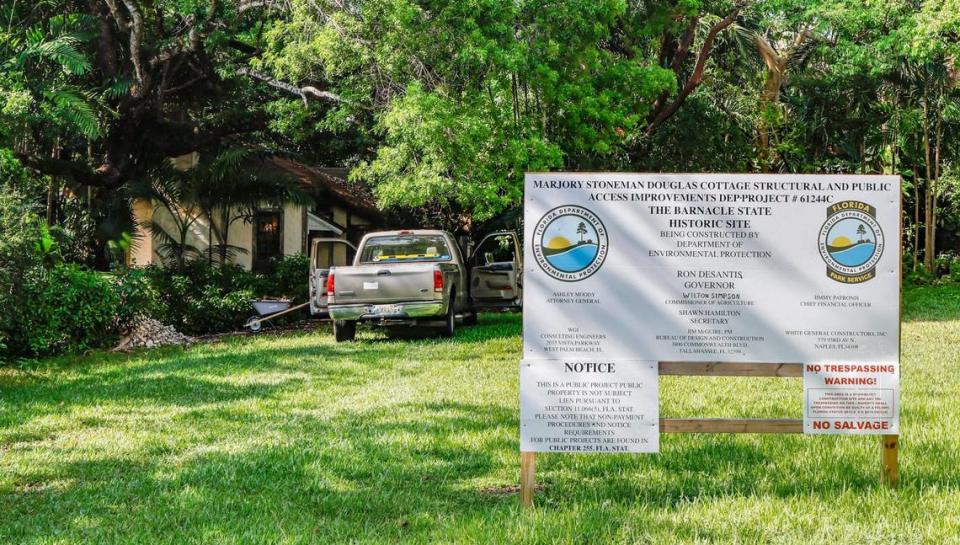Decaying Grove cottage of Florida’s most famous environmentalist getting fixed. Finally
The Coconut Grove cottage where Marjory Stoneman Douglas wrote “The Everglades: River of Grass” — the book that would change America’s perception of the Everglades and make her Florida’s most famous environmentalist — has been slowly decaying since her death there in 1998.
Talk of restoring it and opening it to the public remained in seemingly perpetual limbo for decades, mired in bureaucratic delays and legal disputes led by surrounding residents in a leafy neighborhood that has gone increasingly upscale since Douglas held court there. At one point, there was even a plan to cut the place in half, truck it away and piece it back together somewhere else.
Now, the small, one-bedroom home is finally undergoing long-awaited repairs and upgrades. State contractors have been quietly working there for months. But the question of when, and if, the public might visit the place remains undecided.
Connie Washburn — a longtime board member of Friends of the Everglades, an environmental advocacy group that Douglas helped found — is happy to see progress after so many years of frustration. She had visited Douglas there before the celebrated writer’s death at age 108.
“I have been working on this house since 1998, and it has gone from what to do with her possessions, to what kind of renovations were going to be made, permitting, more permitting, more permitting,” Washburn said.

The house was declared a National Historic Landmark in 2015 but somehow no marker had been placed about the designation. Friends of the Everglades had one created years ago, and Washburn is eager to see it placed in the lawn.
“It will be lovely,” Washburn said. “I really hope it happens before I leave this earth. I’ve been working on it for so long.”
Washburn, however, is on the side of keeping the little home itself closed to the public, providing instead an online portal with a video tour, perhaps on the group’s website. The lot, after all, has enough room to handle only a few cars if parking spaces replace some of the grass.
Other Douglas fans are also pleased restoration work is starting but argue the life of the state’s most charismatic and effective champion of the Everglades deserves wide exposure.
From penning her book there to sharing five o’clock cocktails with friends, the modest home played a central role in Douglas’ life, said University of Florida history professor Jack Davis, author of “An Everglades Providence: Marjory Stoneman Douglas and the American Environmental Century.”
“I think it’s important for people to see that house, see Marjory Stoneman Douglas for the full person that she was beyond the ‘grandmother of the Everglades’,” Davis said. “And that clearly comes through when you walk into the house. It has a real impact on you.”
Davis wants the house to be open to the public to honor her impact on the South Florida community.
“It’s really sad that we’re forgetting her. I’ve taught at University of Florida for 21 years, and for years I’ve asked my students, ‘How many of you are familiar with Marjory Stoneman Douglas, before the Parkland shooting?’ Virtually no hand would go up.” Davis said. Seventeen students and staffers were killed and another 17 were injured in the 2018 mass shooting at the high school named for her in the northwest Broward County city.
Douglas herself designed and had built the 916-square-foot cottage at 3744 Stewart Ave. in 1926. The most important part of the house for her was the living and study area, which boasts high ceilings, beautiful woodwork and natural light. There is no driveway, because she didn’t drive. And it wasn’t until she was 100 years old that air conditioning was installed — because her secretaries asked for it.
In a testament to Douglas’ strong will, when the cottage was partly constructed, it withstood the Great Miami Hurricane of 1926.
The Florida Department of Environmental Protection began construction efforts in 2023 meant to restore the home to its original state and eventually move Douglas’ furniture back. A sign at the site announced the ongoing work.

The restoration work comes after years of public debate over what to do with the house.
Sallye Jude, a friend of Douglas and environmental preservationist who died in 2022, managed a land trust that allowed the state to purchase the house in 1991 under the agreement Douglas could live there for the remainder of her life.
Jude managed the trust until the state took over in 2007. The same year, the state proposed cutting the cottage into pieces and moving it to Fairchild Tropical Botanic Garden for display. The state dropped the plan amidst protests, citing moving costs. The debate over what to do with the place dates back to not long after Douglas died, with neighbors divided on restoration or removal.
In 2018, Coconut Grove residents settled on allowing the house to be open to the public, but only through appointments. But disagreements between the land trust and the state over costs halted progress. Meanwhile, some neighbors also continuously complained about the decrepit state of the cottage.
The Florida Department of Environmental Protection, which oversees the property, first posted a bid for restoration in August 2022 and a construction contract was executed in April 2023. But after discovering the house would need more work to meet code requirements, the agency submitted a change order in late 2023. A resulting structural-assessment proposal calls for a final completion date of the work this August, according to DEP records.
Contractors declined a request to tour the inside of the cottage but the DEP says they are working on large- and small-scale maintenance and improvement projects. That includes extensive, ongoing work to address stormwater and structural issues, as well as bringing the house up to modern code standards and addressing termite and mold issues, according to Brian Miller, DEP press secretary.
“It presents unique challenges for land and resource managers,” Miller wrote in an email response to the Miami Herald. “DEP has and is continuing to evaluate how to best navigate these challenges in accomplishing our mission while considering the needs and desires of the surrounding community.”
Eve Samples, executive director of Friends of the Everglades and a former journalist, said the decades of delay have been frustrating, but she is relieved there is now time dedicated to restoring the humble home that she called a “cultural treasure in Miami.”


